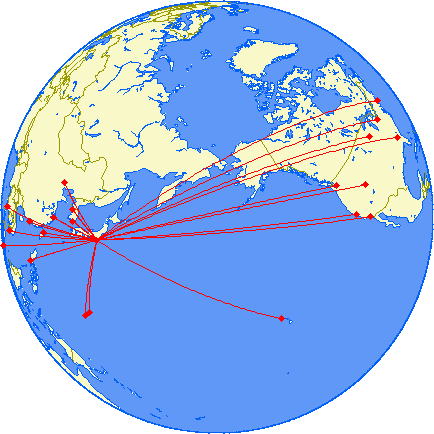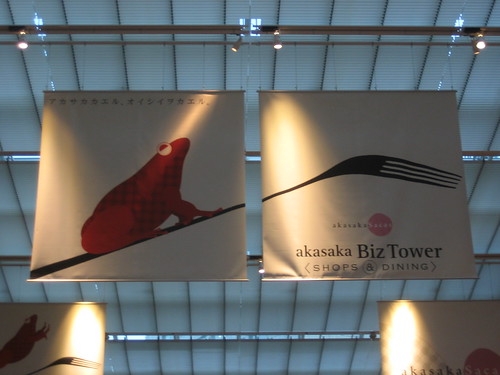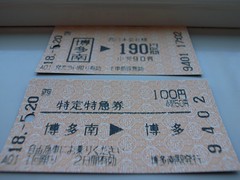Various media sources have been reporting that JAL is now the subject of a tug-of-war between Delta and American Airlines, both of whom are interested in taking a large minority stake in Japan’s largest airline. (Korean Air and Air France have also popped up as “angel investors” in some reports.)
Let’s start with some background.
 This is the ex-Narita route map of Delta Air Lines following its acquisition of Northwest. Delta is the #3 carrier at Narita with about 330 flights/week, compared to JAL’s 870 and ANA’s 500.
This is the ex-Narita route map of Delta Air Lines following its acquisition of Northwest. Delta is the #3 carrier at Narita with about 330 flights/week, compared to JAL’s 870 and ANA’s 500.
Northwest, whose operations account for the vast majority of Delta’s combined total, was the first airline to serve Japan following World War II. It provided the technical assistance which was necessary for JAL to start up in the early 1950s, and it has maintained an Asian mini-hub in Tokyo since the immediate postwar era. Delta came into the picture much later: they flew a very odd Portland-Nagoya route for a while in the 1980s, then pulled out of Japan completely, then came back in the 90s with a daily Atlanta flight. While Northwest was well-entrenched with travel agents and corporate travel desks, Delta relied more on feed from its US and Latin American route network out of Atlanta.
Now that Delta has absorbed Northwest, American is the small fry among US carriers at Narita, with just 70 weekly flights in comparison to Delta’s 330, United’s 150 and Continental’s 80. Despite this, AA has great marketing in Japan and their brand is fairly well-known here. Their saving grace is an extensive partnership with JAL through the oneworld airline alliance: JAL sells tickets on AA transpacific and US domestic flights, while AA sells tickets on JAL transpacific, Asian and Japan domestic flights. The carriers also cooperate with each other’s mileage programs, so that one can get JAL miles by flying AA, and vice versa.
AA has been doing fairly well lately, at least as far as US “legacy” airlines go. It just raised a cool billion dollars by selling frequent flyer miles to Citibank, which will, in turn, be dishing out more and more AA miles to credit card holders in the future. It also has more efficient planes trickling in to replace older MD-80 models in its US domestic fleet, which will improve its overall fuel efficiency and make it more competitive with the likes of Southwest and JetBlue.
JAL, on the other hand, is a financial disaster. Its “equal merger” with Japan Air System, which was supposed to make it more competitive in the domestic market, ended up creating two tracks of unionized employees, aircraft and operational infrastructure within the company, and this dichotomy has still not been sorted out. JAL still has a smattering of international routes that it doesn’t really need, most of which date back to the postwar economic explosion when the government basically tried to get JAL to fly everywhere in the world, on top of the extensive ex-JAS network within Japan that generally doesn’t mesh with the international network at all. On top of that, it has a huge, disorganized and fuel-hungry fleet of planes, and no money to swap them all out for a more streamlined fleet. JAL today looks a lot like Pan Am did in the 80s, and we all know what happened to Pan Am.
The Ministry of Land, Infrastructure and Transport has been pressing JAL to tie up with Delta for a few months now, according to media reports. Its reasoning is that the two carriers can code share, fill each other’s empty seats and tacitly cede certain markets to each other’s flight operations, much as JAL and American do now. Since Delta has many more routes from Narita, and significant overlap with JAL’s route network, turning the two competitors into allies would help JAL’s finances and justify some level of public funding to keep them afloat. Or at least, that was MLIT’s reasoning as of Taro Aso’s last day in power: New Transport Minister Seiji Maehara is being mum about the situation and implying that the Development Bank of Japan and private financial institutions may be on their own in financing a turnaround plan.
Delta has its own initiative to throw money on the table, and Delta’s interest basically explains American’s interest. I’ll let Cranky Flier, one of my favorite aviation bloggers, explain:
My guess is that [Delta’s Asian routes out of Narita] absolutely suck wind right now. If Delta is really losing a ton of money as I suspect, they could eliminate all those routes and either use the slots to fly to the US or transfer them to JAL. The additional connectivity in Tokyo that they could gain from this link-up would add a bunch more traffic to feed all that US-Tokyo flying Delta does now. (You people in Portland could breathe a sigh of relief, because this could probably help that flight come off the edge of the cliff.)
This move could make a big, immediate difference on the bottom line. If Delta can pour some money in but get it back out very quickly in the form of improved profits, then it’s a no-brainer. …
Of course, if JAL leaves, oneworld loses, so American has now come back with its plan to invest in JAL.
To this, I would only add that although Delta has inherited Northwest’s excellent sales and operational staff in Tokyo, Delta has not been making much effort to publicize its acquisition of Northwest here, except through a few ads here and there that are apparently direct translations of the ads they use in the US. This indicates to me that they are not particularly interested in developing their brand in Japan, despite the fact that it is now their most important overseas market. It’s much easier, from Delta’s perspective, to let JAL sell seats out of Japan under its own brand.
Some analysts and reporters have also raised the topic of Haneda slots, with very little clarification as to why Delta would care about Tokyo’s downtown, mostly-domestic airport. As many MFT readers know already, the Japanese government is slowly making Haneda more international. They are building a new international terminal and have started the legal documentation necessary to allow nonstop service from Haneda to Southeast Asia, Europe and other new destinations, primarily during late-night and early-morning hours when Narita is closed. The United States is not on the table yet, but many observers believe that an “open skies” treaty to open the aviation market between Japan and the US is long overdue, and with that treaty would come the ability to serve Haneda from the US. The most interesting aspect of Haneda for trans-pac flyers is that it will be open 24 hours, potentially allowing early morning or late-night flights between Tokyo and the West Coast that wouldn’t eat up a working day on either side of the ocean. Delta and American should both have an interest in such a service, especially if they can be assured of good domestic feed within Japan out of Haneda, which JAL is best positioned to provide.
It won’t be an easy ride, though. Whoever bails out JAL will have to sort through their mess of operational issues in order to get some return on the investment.




